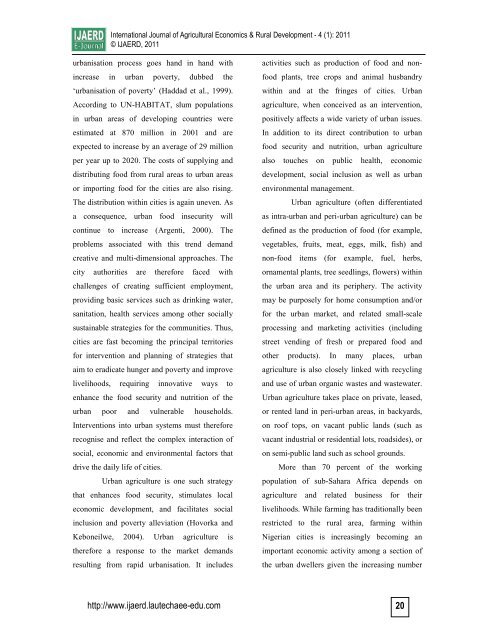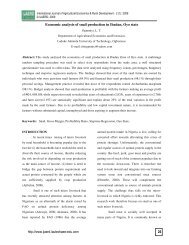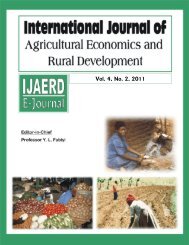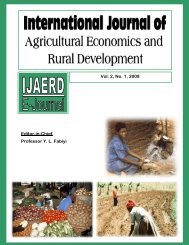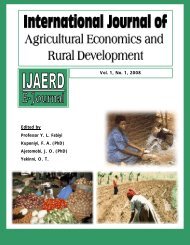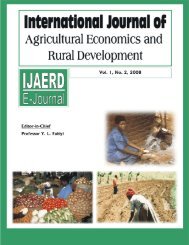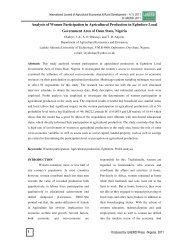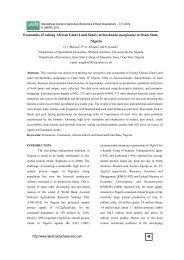Vol 4 No 1 2011
to download the whole journal - Lautechaee-edu.com
to download the whole journal - Lautechaee-edu.com
- No tags were found...
Create successful ePaper yourself
Turn your PDF publications into a flip-book with our unique Google optimized e-Paper software.
International Journal of Agricultural Economics & Rural Development - 4 (1): <strong>2011</strong><br />
© IJAERD, <strong>2011</strong><br />
urbanisation process goes hand in hand with<br />
increase in urban poverty, dubbed the<br />
‘urbanisation of poverty’ (Haddad et al., 1999).<br />
According to UN-HABITAT, slum populations<br />
in urban areas of developing countries were<br />
estimated at 870 million in 2001 and are<br />
expected to increase by an average of 29 million<br />
per year up to 2020. The costs of supplying and<br />
distributing food from rural areas to urban areas<br />
or importing food for the cities are also rising.<br />
The distribution within cities is again uneven. As<br />
a consequence, urban food insecurity will<br />
continue to increase (Argenti, 2000). The<br />
problems associated with this trend demand<br />
creative and multi-dimensional approaches. The<br />
city authorities are therefore faced with<br />
challenges of creating sufficient employment,<br />
providing basic services such as drinking water,<br />
sanitation, health services among other socially<br />
sustainable strategies for the communities. Thus,<br />
cities are fast becoming the principal territories<br />
for intervention and planning of strategies that<br />
aim to eradicate hunger and poverty and improve<br />
livelihoods, requiring innovative ways to<br />
enhance the food security and nutrition of the<br />
urban poor and vulnerable households.<br />
Interventions into urban systems must therefore<br />
recognise and reflect the complex interaction of<br />
social, economic and environmental factors that<br />
drive the daily life of cities.<br />
Urban agriculture is one such strategy<br />
that enhances food security, stimulates local<br />
economic development, and facilitates social<br />
inclusion and poverty alleviation (Hovorka and<br />
Keboneilwe, 2004). Urban agriculture is<br />
therefore a response to the market demands<br />
resulting from rapid urbanisation. It includes<br />
activities such as production of food and nonfood<br />
plants, tree crops and animal husbandry<br />
within and at the fringes of cities. Urban<br />
agriculture, when conceived as an intervention,<br />
positively affects a wide variety of urban issues.<br />
In addition to its direct contribution to urban<br />
food security and nutrition, urban agriculture<br />
also touches on public health, economic<br />
development, social inclusion as well as urban<br />
environmental management.<br />
Urban agriculture (often differentiated<br />
as intra-urban and peri-urban agriculture) can be<br />
defined as the production of food (for example,<br />
vegetables, fruits, meat, eggs, milk, fish) and<br />
non-food items (for example, fuel, herbs,<br />
ornamental plants, tree seedlings, flowers) within<br />
the urban area and its periphery. The activity<br />
may be purposely for home consumption and/or<br />
for the urban market, and related small-scale<br />
processing and marketing activities (including<br />
street vending of fresh or prepared food and<br />
other products). In many places, urban<br />
agriculture is also closely linked with recycling<br />
and use of urban organic wastes and wastewater.<br />
Urban agriculture takes place on private, leased,<br />
or rented land in peri-urban areas, in backyards,<br />
on roof tops, on vacant public lands (such as<br />
vacant industrial or residential lots, roadsides), or<br />
on semi-public land such as school grounds.<br />
More than 70 percent of the working<br />
population of sub-Sahara Africa depends on<br />
agriculture and related business for their<br />
livelihoods. While farming has traditionally been<br />
restricted to the rural area, farming within<br />
Nigerian cities is increasingly becoming an<br />
important economic activity among a section of<br />
the urban dwellers given the increasing number<br />
http://www.ijaerd.lautechaee-edu.com 20


